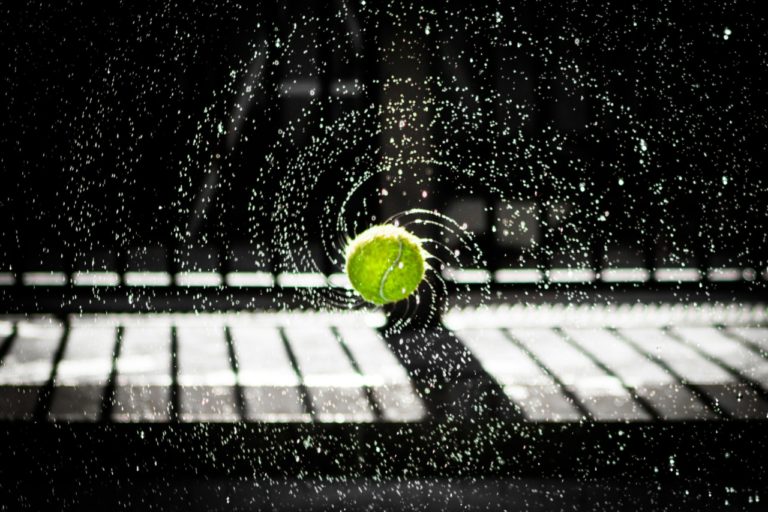technology is discretely taking the tennis court, too
Following the Australian Open (won by the italian Jannik Sinner, hooray!) let’s explore what technology lies behind – and around – the tennis court
As technology continues to advance, it’s no surprise that it has a major impact on the way we experience sports. One area in particular where we’re seeing significant improvements is in the world of tennis.
Technology has undoubtedly had a significant impact on tennis as a sport in recent years. From the introduction of AI to the new video review technology, these advancements have revolutionized the fan experience and how players and coaches approach the game. From electronic line calling to new video reviews for chair umpires, technology is truly enhancing the fan experience in countless ways
How Technology is Improving the On-Court Experience
While technological developments are enhancing the fan experience, there are also numerous technologies revolutionizing the player experience as well. While some argue that technology has taken away from the human element of the sport, there is no denying that it has also made the game more accurate and fair.
Video Review Technology
One technology shaking things up at the tennis court is undoubtly the new Video Assistant Referee (VAR) technology. The video review technology will assist chair umpires when a player challenges a specific set of judgment calls such as double bounces and foul shots. This technology is certainly a game changer as it is expected to eliminate human error from judgment calls should a player choose to challenge a call.
The introduction of the video review technology at the US Open, for instance, initially received positive feedback, However, after malfunctioning in its debut on a crucial call in a first-round match between Andy Murray and Corentin Moutet, fans were outraged by this new technology. The malfunctioning of the technology in such a high-stakes moment might pose a challenge in regaining trust and favor for the system. Yet, as with any technological innovation, a period of adaptation and refinement is often necessary before widespread acceptance can be achieved.
Hawk-Eye Line-Calling System
While not a brand-new addition to the world of tennis, the Hawk-Eye Line-Calling System has been an innovative addition to the tennis world to determine whether the ball is in or out. It relies on multiple camera angles to meticulously trace the tennis ball’s path, merging them to create a precise 3D model of its trajectory.
In an interesting turn of events in 2020, the US Open made a significant change by introducing Hawk-Eye Live on 15 out of 17 match courts. This upgraded version of the system can make instant automated calls in real time, and it quickly gained widespread acceptance at the US Open.
More recently, at the Australian Open won by italian player Yannik Sinner, the Hawk-Eye technology was used to conduct electronic reviews of disputed line calls. All Hawk-Eye systems at AO used high-speed cameras to generate visual images that enable the tracking of the flight path of a struck tennis ball, determining whether the tennis ball landed in or out of bounds. The Australian Open adopts the ‘three-plus-one’ electronic review system. Players will receive three incorrect challenges during each set and a fourth challenge if a set goes to a tiebreaker.
Shifting player expectations
The incorporation of video review technology in tennis has significantly shifted player expectations across the sport. With more opportunities for fair and accurate calls, players can focus on their skills and strategy rather than the fear of a flawed call costing them the game. While it may take some time to work through malfunctions in the technology, the shift towards implementing video review technology continues to grow, ultimately changing the way players approach matches.

How Technology is Enhancing the Fan Experience
AI-Generated Spoken Commentary
To no surprise, AI is playing a major role in enhancing the fan experience, at it happened at the US Open this year. In a partnership with USTA, IBM utilized its AI platform, Watsonx, to provide dynamic audio narration and captions for highlight videos featured across the U.S. Open’s digital platforms. These real-time voice updates go beyond mere scores, offering insights into the gameplay’s nuances and highlights.
IBM’s Draw Analysis AI is a groundbreaking statistic tool for tennis, analyzing player strengths, weaknesses, historical performance, and potential paths to victory. Moreover, the AI assesses each player’s real-time performance, enabling a richer audio feed for fans worldwide. These AI-powered enhancements complement existing tools like the IBM Power Index Leaderboard, Match Insights, and Personalized Highlights Reels on the Wimbledon App and website.
As AI continues to shape and enhance various facets of the tennis world, its influence on the sport’s future is becoming increasingly pronounced.
Social Media Integration
In the era of pervasive social media, platforms like Twitter and Instagram provide athletes the opportunity to connect with fans in a more personal and meaningful way. Whether it’s simply talking to fans on their Instagram story, sharing elements of their personal life, or highlighting various partnerships, social media provides a unique athlete-to-fan connection that makes cheering these tennis stars on even more enjoyable for fans when it comes down to match time.
This social media fervor amplifies the influence of these events, turning them into trending topics and cultural touchpoints. This represents a golden prospect for brands to forge partnerships with the athletes and even the event’s attendees, seamlessly integrating their products into the glamorous narrative. By doing so, brands can harness the power of both the physical event and its digital reverberations, cultivating brand visibility and resonance among a global and engaged audience.
Increase in popularity among younger fans thansk to social media
In recent years, there’s been an exciting rise in the popularity of tennis among younger fans. This surge is thanks in large part to the influence of social media platforms like Instagram and TikTok, which have become central to the digital world. These platforms have become essential touchpoints for the younger generation, drawing them into the world of tennis.
To sum it up, the allure of tennis for the younger generation is intertwined with the digital world. Social media has brought tennis stars closer to their fans, transforming them into companions on a shared journey. The mix of celebrities and influencers at tennis events has given the sport an extra boost, making it a cultural spectacle. This exciting relationship between tennis and the youth promises a bright future, where generations come together and the love for the game continues to grow.
What used to feel like a distant gap between tennis stars and their young fans has now been bridged by the active presence of these athletes on social media. Through platforms like Instagram and TikTok, these players have gone from being distant figures to relatable personalities. By sharing glimpses of their lives beyond the tennis court, they’ve created a genuine connection that resonates with the younger audience.

The future of technology in tennis
Wearable technology finally takes center stage in tennis
Wearable technology is everywhere in tennis. Already an indispensable part of most athletes’ pre- and post-match routines, these technologies are increasingly making their way onto the tennis courts—and in some cases, even in competition.
What’s wearable tech
“Wearable technology” refers to any device that is attached to the body—that is, worn on the person, including as an accessory like a bracelet or embedded into clothing and gear—and is used to measure performance during physical activity. It’s not just limited to athletes, with devices including the Fitbit, WHOOP Strap, Apple Watch and more allowing almost anyone to measure and track various aspects of their health and performance.
For professional tennis players, these insights can be used to analyze performance data, optimize practice sessions, monitor injury rehab and post-match recovery, track sleep patterns and blood oxygen levels, and much more. In an individual sport like tennis, having access to hyper-personalized analytics with information pulled from various sources is increasingly vital. Adding physiological data to match and practice data can help paint the complete picture of a player’s performance.
GPS tracker
In 2019, the ITF – International Tennis Federation, approved Catapult Sports’ OptimEye S5—a small, palm-sized gadget that slides into the back of a small vest—as the first GPS device that can be worn in competition. Later that year, the ATP Tour tested the technology during Next Gen Finals matches in Milan. By now, the black Catapult vest is a familiar sight in practices: Andy Murray wore one throughout his recovery from hip surgery under the advice of his strength coach, Matt Little.
Fitness tracker
At the end of 2021, the WTA Tour made another big move into this space after inking a multi-year deal with the fitness tracker WHOOP, making it the first wearable technology approved for in-match use on the women’s tour. Sloane Stephens, who also signed on as the brand’s ambassador, prominently wore the strap at the Australian Open. But wearable technology has added another layer of context to that data—and with it, an added another layer for coaches, trainers, and players to sift through. How does a player’s heart rate change when they are down break point, and how do those nerves then affect shot production? How much effort is a player expending running during rallies, and what is the more efficient way to construct points? These are the types of granular insights that modern players can now consider.
At the Australian Open, physiological stats measuring a player’s effort in kilojoules (kJ), tracking sprint speeds and recording changes of direction in a rally were displayed alongside the typical tennis stats like winners, unforced errors and first-serve percentages. And through their partnership with WHOOP, the WTA is also planning to incorporate real-time data into broadcasts.
A game changer for fans, too
With (approved) wearables slowly making their way into elite competition, the digital transformation of sports promises to not only drastically change how a player approaches fitness and match play—hopefully, keeping them healthier longer—it’s also bringing a whole new element to the tennis viewing experience. And the sports tech revolution is just getting started.
In the evolving landscape of tennis, athletes have taken on roles beyond the court as influential public figures. As explained above, this transformation has been amplified by the rise of social media, where athletes have become “influencers,” a shift further accentuated by the growing intersection of sports and fashion.
Crossing the line between sport, lifestyle, business
Looking ahead to the future, an intriguing avenue emerges at the nexus of technology and tennis fashion. Envision incorporating NFC tags into their clothing, offering dedicated fans access to exclusive behind-the-scenes content, exciting giveaways, and special offers. This innovative integration of technology and tennis not only pushes conventional boundaries but also enriches the fan experience, forging an unparalleled connection between players and their supporters.
Without a doubt, the most recent Opens demonstrates how technology can be utilized in the most creative ways. But it’s important to keep in mind the effects of this technology on both players and fans. Every sports league should take note that increased levels of technology has and will continue to have an impact on the performance, fan experience, media partnerships, and expectation for athletes. So whether as spectators or participants involved in tennis at any level, it is our collective responsibility to consider all implications of technological advances while still enjoying its positive impacts on the beloved game.
The role of the International Tennis Federation
The International Tennis Federation is the centre of excellence for all tennis science research. Its focus on innovations in tennis includes Player Analysis Technology, Electronic Line Calling and its latest research into the state of the game
The International Tennis Federation (ITF) is the world-wide governing body of tennis and has the following broad areas of responsibility:
- administering and regulating the game
- organising international competitions
- structuring the game
- developing the game
- promoting the game
The ITF Technical Commission is responsible for monitoring developments in equipment technology in order to protect the nature of the game of tennis at all levels.
As custodians of the Rules of Tennis, the ITF has the sometimes difficult task of judging whether innovations in tennis equipment may bring about a benefit to those who play, or whether such developments constitute a threat to the nature of the game.
The ITF Technical Center
In 1997, the ITF created its own Technical Centre with a laboratory and staff whose task it is to carry out testing and research into all aspects of the game, and to provide support to the ITF Technical Commission and other ITF Committees on decisions relating to technical issues. This facility is now a world-leading tennis research and
testing laboratory. The ITF Technical Centre is the world’s most advanced tennis-specific research facility, with over a million dollars’ worth of equipment allowing its staff to research all of the technical aspects of tennis innovation.
sources: CollectD.io I ITF I FD Tennis
cover image: Josh Calabrese via Unsplash
Maker Faire Rome – The European Edition has been committed since its very first editions to make innovation accessible and usable to all, with the aim of not leaving anyone behind. Its blog is always updated and full of opportunities and inspiration for makers, makers, startups, SMEs and all the curious ones who wish to enrich their knowledge and expand their business, in Italy and abroad.
Follow us, subscribe to our newsletter: we promise to let just the right content for you to reach your inbox.



















































































